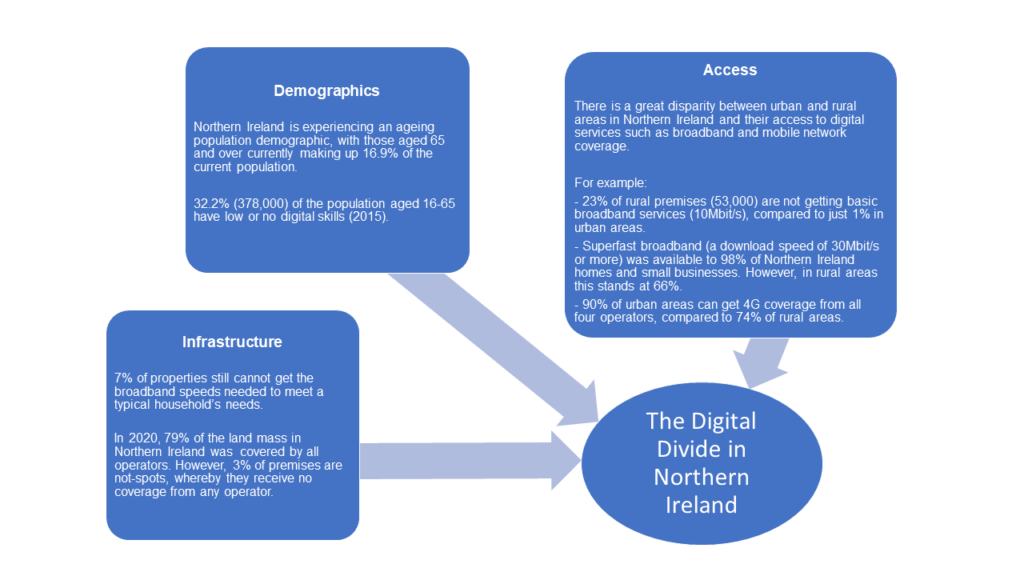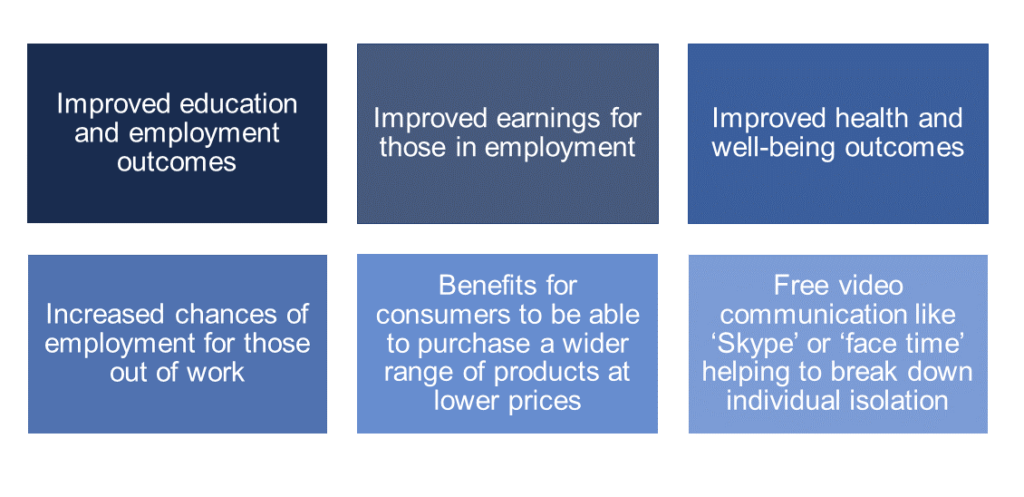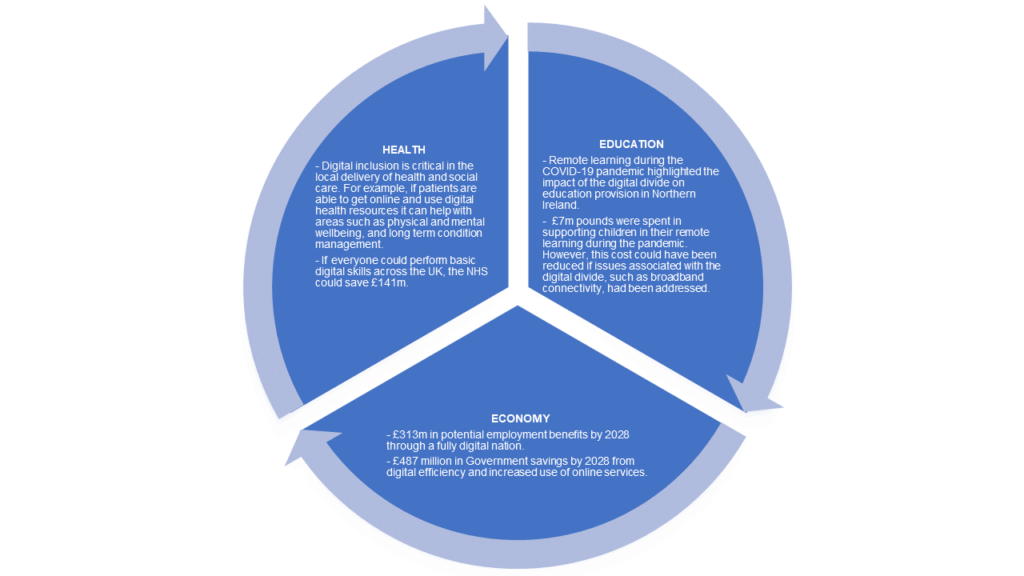
This blog article provides a brief overview of the ‘Digital Divide’. Drawing on the Northern Ireland experience, it explores key characteristics of the Digital Divide, as well as the importance of closing this divide, especially given exigencies we have faced throughout the COVID-19 pandemic.
What is the ‘Digital Divide’?
The Digital Divide broadly refers to the gap between people, households, businesses and areas in both accessing information and communication technologies (ICTs) and using those technologies – that is, opportunity and ability. Critically, there are different components of the digital divide, encompassing a wide range of features, such as broadband and mobile coverage, as well as digital skills needed to engage with technology. The divide is not only a technological problem, but also a social and economic problem as those not connected cannot access services, goods, knowledge and opportunities, which gives rise to inequalities.
What does the Digital Divide look like in Northern Ireland?
In respect to the rest of the United Kingdom (UK), Northern Ireland continues to have the highest proportion of internet non-users; standing at 14.2%. The Digital Divide is a serious challenge facing Northern Ireland today. However, not all areas in Northern Ireland are experiencing the divide in the same way.
First, Northern Ireland is sparsely populated, and as such District Councils are experiencing the divide differently. For example, using broadband speed as an indicator, it can be seen that there is great variation amongst the Councils. Unsurprisingly, a relationship between population density and broadband speed can be found, with lower speeds found with those Council areas with a sparser population. Causeway Coast and Glens, however, goes against this trend. Figure 1 below highlights such variation:

It seems that assessing the percentage of those who receive a broadband coverage of less than 2 Megabits per second (Mbps) could be a concern under the UK’s broadband Universal Service Obligations (USO). This is because individuals now have the right to request a broadband connection of at least a download speed of 10 Mbps and an upload speed of 1 Mbps. Comparing these coverage rates to the rest of the UK: Northern Ireland continues to have the lowest coverage of superfast broadband in the UK (90.2%); with England having the highest (97.5%); followed by Wales (96%) and then Scotland (94.8%).
Within the context of Northern Ireland, Fermanagh and Omagh present the highest rates of poor broadband coverage of <2 Mbps, which is below the USO. However, this can be associated with the broader urban-rural Digital Divide. Within the UK as a whole, there is an urban-rural divide; with many rural areas experiencing poor or even no access to broadband and mobile coverage services. Notably, 5.4% of premises located in a rural setting do not receive the USO broadband connection requirement; compared to 1.2% in urban areas. While 44% of rural areas receive 4G coverage, in comparison to 84% of urban areas across the UK.
Moving beyond the indicator of broadband coverage, and trying to understand why Northern Ireland continues to have the highest proportion of internet non-users, it is important to explore the broader context of the Digital Divide in Northern Ireland, which reveals many outdated data sets. Moreover, there is a severe lack of data on a yearly basis. Also, wide-scale index reports, such as the Lloyd’s Consumer Digital Index report, often exclude Northern Ireland from its data sets, due to the smaller scale of analysis that is required.
Consequently, there is an apparent need to gather data more frequently in the case of Northern Ireland. This is important to note given the pace of digital technology and its rollout throughout society. As such, accurate platforms that enable comparisons to be made across the UK, and allow for the tracking of progress, are needed to identify patterns and trends. Such monitoring and evaluation are imperative if existing Digital Divide issues are to be addressed and progress to be made, including reducing any inequalities arising from the Divide.

Figure 2 highlights the interrelationship between the different factors that collectively produce the Digital Divide in Northern Ireland. It shows that the divide goes beyond the ability to receive a decent broadband connection. There appear to be three broad categories of issues driving the divide in Northern Ireland: access, infrastructure and demographics.
One of the most notable factors of this divide is the high number of individuals who are of working age (16-65) and those who have little to no basic digital skills. Essential digital skills fall into five central categories: managing information, communicating, transacting, problem solving, and creating. These categories encompass everyday activities such as using a search engine, sending an email, ordering shopping online or creating a document such as a CV.
In the UK, 8% of people (4.3 million people) have zero basic digital skills, with a further 12% (6.4 million adults) estimated to have limited digital skills (unable to perform at least one of the basic digital skills). Breaking those figures down by region: 20% of the populations of England and Scotland have no basic digital skills; while in Wales this figure stands at 34%. In the case of Northern Ireland, 32% of the working age population (16-65) have limited or no basic digital skills. That is higher than the UK average of 26%. It is inevitable that existing digital skill gap levels throughout the UK population will influence, to a lesser or a greater extent, employment aspirations, social relationships and in turn the broader economy. This is because many work-related activities are moving online and changes to home working patterns require employees to operate technologies remotely. Over the last couple of years, that trend was accelerated by the COVID-19 pandemic, which has required employees to have basic understandings and an ability to use digital technologies.
In Northern Ireland, this seems to be especially acute given that rural areas are home to more than a third of the population; and that the rural population is growing. Rural areas are home to 58% of businesses in Northern Ireland; with 74% of the population being in either full-time or part-time employment. As of 2019, only 4% of the rural population worked from home. However, this figure is expected to increase, following the shift towards remote working following the COVID-19 pandemic. A good case therefore exists for expanding broadband, and in particular superfast services to rural areas. Doing so has the potential to attract business investment to rural areas in Northern Ireland and boost workers’ productivity, enabling them to access and use fast, reliable broadband.
In Northern Ireland there is a strong crossover with ageing populations, rural areas, and access and ability to use digital services. Across the UK, 80% of those who are offline are aged 50 and above; likewise, 90% of those who cannot perform essential digital skills are over the age of 55. In Northern Ireland, 18% of the rural population are aged 65 and over. Drawing upon the aforementioned statistics surrounding the relationship between age and digital exclusion, rural communities with older populations pose a problem in attempting to tackle the Digital Divide in Northern Ireland, leaving them at further risk to be left behind.
Furthermore, with a growth in rural populations in Northern Ireland, there could be an increased demand for services such as broadband and mobile network coverage, which could further widen the Digital Divide between urban and rural areas. This is very significant as the Digital Divide gives rise to inequality as those not connected cannot access services, goods, knowledge and opportunities.
Why is closing the Digital Divide important?
Reducing the number of those who are offline, and unable to both effectively access or use such technologies, may provide benefits to individuals and society as a whole. First, from the perspective of the individual, it strengthens that person’s employability, as well as ability to interact with others, reducing the chances of social isolation, as highlighted in Figure 3 below:

Taking a more strategic look, Figure 4 below shows some of the vast savings potentially made in a digitally inclusive society, not only to the economy, but also to other sectors in Northern Ireland, such as education and health:

Impact of the COVID-19 pandemic on the Digital Divide
The impact of COVID-19 has shown how important digital technologies are in keeping people connected. This can be seen through the shift of essential services online, such as medical and banking appointments and education services, alongside an increase in the number of people working from home. The current climate has further highlighted the importance of digital connectivity and the subsequent need to tackle digital exclusion. Although some may not want to be online, many may be left behind in this increasingly digital world.
The World Economic Forum has labelled the Digital Divide as one of the central global risks facing the world today; they note:
COVID-19 has accelerated the Fourth Industrial Revolution, expanding the digitalization of human interaction, e-commerce, online education and remote work. These shifts will transform society long after the pandemic and promise huge benefits, but they also risk exacerbating and creating inequalities…
Summary
In summary, this blog article has shown that the Digital Divide is a serious issue facing Northern Ireland today. Critically, there are a number of factors which are contributing to this divide, which has been further exacerbated by the COVID-19 pandemic. Through identifying three broad categories (demographics, infrastructure and access) which characterise the Digital Divide, it demonstrates that this divide is not only a technological problem and that it is in fact an issue which has broader implications to society and the wider economy.

